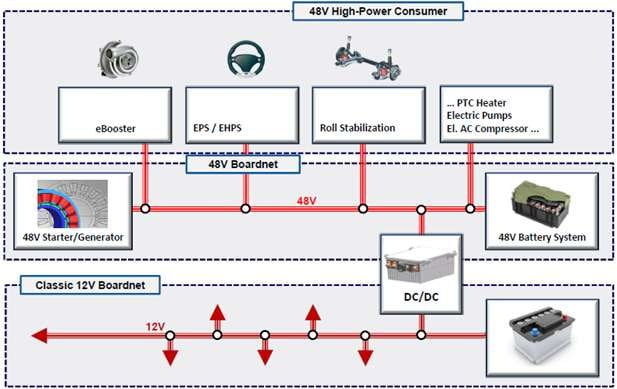Many times we have question in our mind that will 12Volt architecture die and Tesla’s 48 Volt architecture will be gamechanger? This article will give some idea on transition of 12Volt Architecture to 48 Volt Architecture.
Development of Low Voltage Systems
The first mass-produced automobiles used 6V architectures beginning in 1918. By the 1950s, large displacement engines in the U.S. made the 6V voltage system insufficient, so automotive companies began connecting two 6V batteries in series to form a 12V low voltage system architecture.
By the end of the 1960s, virtually all automobiles used 12V voltage systems, and electrical systems and components such as power windows, interior lighting, cigarette lighters, brake lights, ignition spark, batteries, etc., were standardized around a 12V universal voltage standard. This has not changed much in the last 60 years.
In a traditional 12V system, each component of a vehicle’s control unit, such as air conditioning, driver assistance, and infotainment, requires a separate set of wires to power it. As cars integrate more and more electrical components, vehicle wiring becomes increasingly complex and inefficient, less and less adapted to electrification and intelligence.
Intelligent electric vehicles with powerful automated driving functions, such as automated driving sensing and computing systems, automated driving actuators, steer-by-wire and drive-by-wire controls, high-speed transmission of 4G/5G information, and so on, all place higher demands on the power supply.
In 2011, Audi, BMW, Daimler, Porsche, and Volkswagen jointly introduced 48 Volt architecture to meet the growing demand for on-board loads and stricter emissions regulations.
Promoters of 48 Volt systems, mainly German car companies, on the one hand, integrated the 48 Volt system into the original 12V system through a DC/DC converter; and at the same time introduced a DC/DC converter device that converts high-voltage power from the power battery into two voltages, 12V and 48V, to drive different components respectively. While these are only improvements to the 12V system, the adoption of higher-voltage electrical systems to alleviate the significant challenges faced in the 12V architecture has been a long endeavor for automakers. The Cybertruck is Tesla’s first electric car to use a 48 Volt architecture system throughout the vehicle.
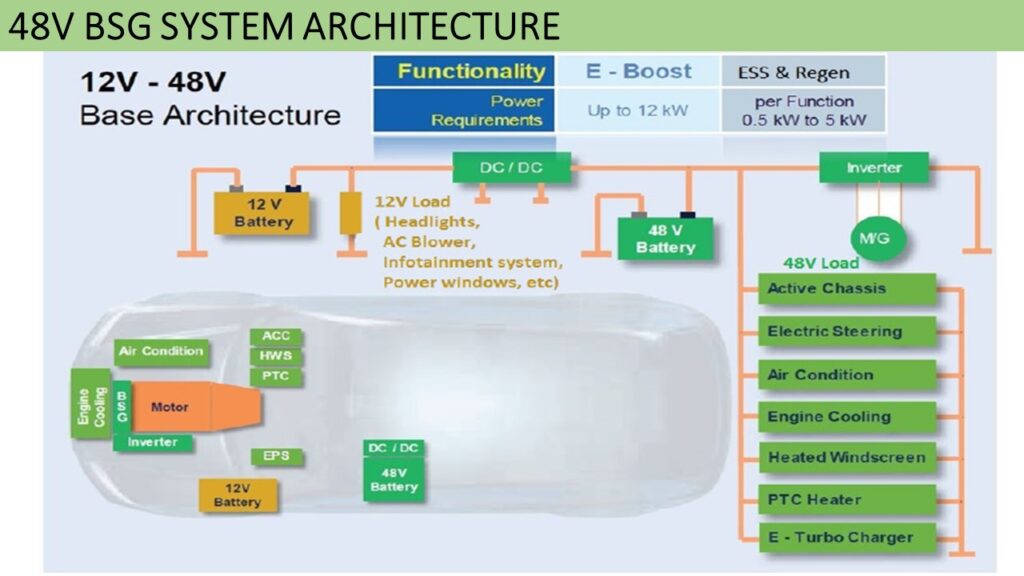
You can also read article on different stages of Vehicle Development.
What are the advantages of a 48 Volt System?
The power of on-board electrical appliances is increasing, so if we don’t increase the voltage, the only way is to increase the current. However, increasing the current will cause the heat generation of the circuit to increase dramatically, and the cross-section of the cables will increase and become thicker, which will bring about a big increase in the weight of the car body and the consumption of electricity, and thus reduce the mileage. Increasing the voltage to 48V or more can ensure the high power required by vehicle appliances, but also reduce energy loss and heat generation in the circuit, which has obvious advantages over the 12V system.
First, 48 Volt architecture systems can provide higher electrical loads, allowing the car to realize more and more power-consuming functions. A 48 Volt system can deliver more power than a 12V system at the same current, while a 48 Volt system can deliver less current at the same output power, which reduces power loss.
Tesla eliminated the 12V battery on CyberTruck and kept only the 48Volt battery, increasing the working voltage to reduce the current; and Tesla designed the variable power module in the ECU to realize the free choice of 12V or 5V voltage.
Second, the 48 Volt system works more efficiently than conventional systems, reducing power loss and providing better durability and safety. 48V systems in the CyberTruck can increase the voltage by a factor of four and reduce the current required by a factor of four, so less energy is lost and less heat is generated by the wiring harnesses, which increases the life and safety of the wiring harnesses and allows the electrical components to respond more quickly. Faster.
Third, lower current means lighter cables, which reduces the size and weight of the cables, allowing for cost savings, as well as more ride space and more batteries.
Since current correlates with the cost of copper materials, reducing current also means significant copper savings. cyberTruck’s use of 48 Volt architecture has helped Tesla reduce wiring by 77% and copper requirements by 50%. The resulting reduction in overall weight and higher efficiency gains could save Tesla approximately $10 billion annually.
Fourth, the 48 Volt system allows for a cleaner vehicle architecture. The Tesla CyberTruck, for example, replaces the CAN bus with a high-speed data bus (Ethernet) that can be daisy-chained to connect most of the components of a legacy system that requires point-to-point wiring to operate.
It’s safe to say that the move to 48-volt electrical architecture represents a game changer for the automotive industry.
Challenges for 48 V Architecture
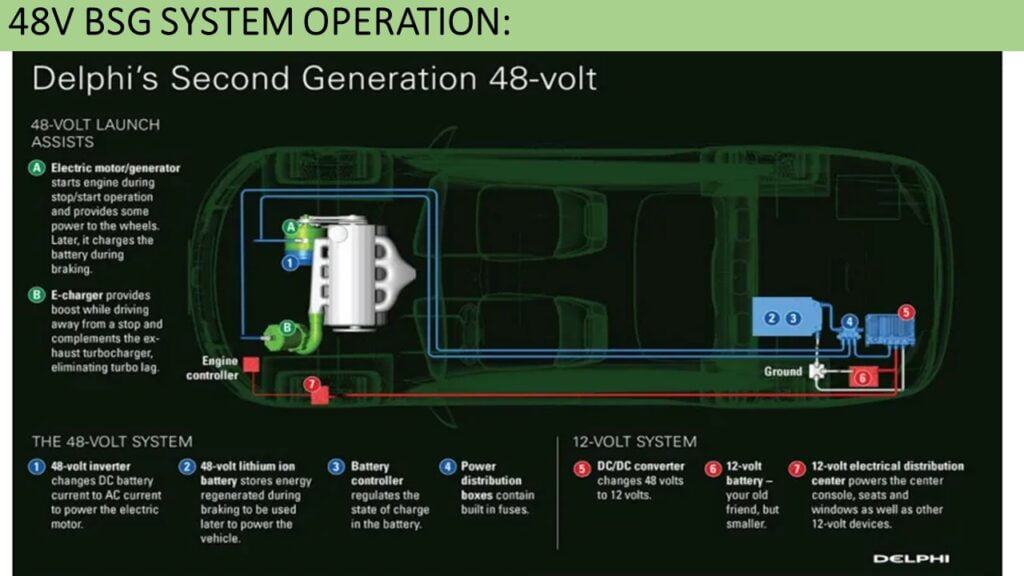
While the 48 Volt system offers many advantages, it also presents new challenges.
First, complexity and security issues are key problems that need to be addressed. In the event of a system failure or security breach, this could lead to serious consequences.
Second, traditional manufacturers’ concerns about adopting new systems are also a constraint. Tesla’s 48 V low voltage system may not be immediately available in any other automaker’s products, and the industry as a whole may take a long time to transition to an updated 48 Volt architecture.
Third, the supplier ecosystem faces reshuffling. A system voltage of 48 Volt means that new components will need to be developed and manufactured to operate at higher voltages. This means a reshuffling of the automotive supply chain ecosystem, which will lead to incremental changes in the way automakers wire, accessory, and electrical engineering.
If an automaker decides to move to a 48 Volt architecture, it will have to build all of its vehicles with accessories adapted to 48 Volt systems. However, suppliers have no incentive to make such accessories without sufficient demand. This is because the unit cost of these 48 Volt parts can be significantly higher than their 12 V counterparts if production volumes are relatively small.
As a result, traditional automakers that rely on third-party suppliers have been slow to implement 48-volt systems. Many automakers will be forced to slowly transition to 48 Volt systems throughout their vehicle lineups.
The Tesla CyberTruck will set the benchmark for the advancement of 48 V systems. As more automakers realize the benefits of 48-volt systems, they will be forced to invest in the necessary technology and infrastructure to make the system switch, which could otherwise result in reduced market share and profitability.
Why Share the 48Volt Architecture
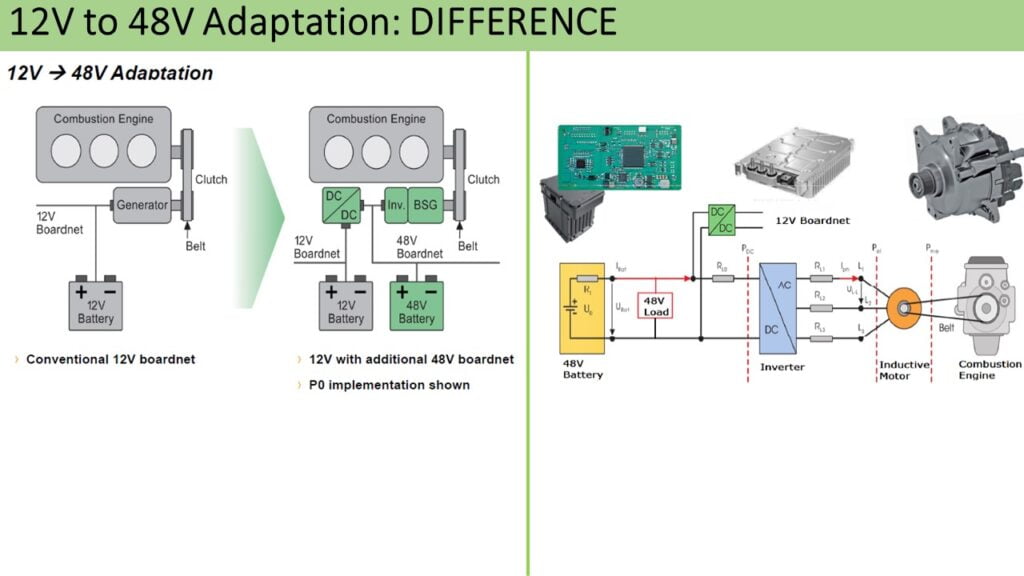
Tesla has two distinct advantages that traditional automakers don’t have when it comes to transitioning to 48 Volt. The first is that Tesla is vertically integrated in the way it builds its cars.
The first is Tesla’s unusual vertical integration in the way it builds its cars – Tesla designs almost all of its automotive systems, even though they may be sourced from third parties.
The second is that Tesla didn’t have a lot of traditional car designs to support or reference when it decided to transition its electrical architecture. Tesla has its own “secret” parts team working on products specifically for the 48 Volt architecture, such as lighting, winches, and air compressors. Tesla’s vertical integration, manufacturing capabilities, and corporate structure provide unprecedented flexibility to design and produce its own highly integrated components in-house, allowing for a rapid transition to 48V systems.
However, Tesla will need to redesign the overall electrical system of its vehicles when it adopts 48Volt; it will need appropriate charging facilities to support its charging needs; it will need to ensure the safety of its vehicles in all aspects of charging, driving, and parking; and it will need to develop appropriate standards and specifications to ensure compatibility and interoperability of Tesla vehicles with other vehicles.
Frankly, Tesla’s sharing of its 48V architecture is not out of pure altruism, but rather a strategic move. Like when it was promoting electric cars, Tesla is trying to make its plate bigger by sharing its technology to jointly advance the change in automotive technology and gain a first-mover advantage in the change.
Tesla knows that transitioning to a 48 Volt system will be very difficult for traditional automakers. Even a company as powerful and well-resourced as Ford3 can’t build a 48 Volt parts supply chain overnight, and the change will create a very large amount of non-recurring engineering work.
Tesla’s sending out the technical documentation is arguably a gesture to other car companies to say, “We’re going to show you how we do this. This thing is complex and difficult and will take years to replicate. You can imitate us.”
And by publicizing its 48Volt architecture, it would also be very beneficial for Tesla to have a wider range of companies in the industry move to 48Volt vehicle systems.
First, by sharing its 48 Volt architecture, Tesla has the potential to benefit from leading the technology while dominating the standards-setting process, just as it did with previous EV patents and charging interface sharing.
Second, it promotes lower supply chain costs. The more components in the global vehicle supply chain that are designed for 48 V vehicle systems, the lower the cost of those components will be over time through volume, competitive engineering, and improved reliability.
Again, this promotes the development of relevant technical talent. Engineers and other skilled workers in the industry will coalesce their work and knowledge around 48 Volt systems, reducing the amount of redundant work that occurs and expanding the shared knowledge base among engineers to contribute to further innovation.
It is difficult to see the negative impact of this move for those in the industry or engineers designing vehicle systems. The supplier ecosystem needs to accelerate the transition to 48 V. The benefits of this transition are enormous.
For Tesla, moving to 48Volt systems not only provides customers with a quality product but also creates a new revenue stream and strengthens Tesla’s brand image as an innovation and design leader.
The Tesla Cyber Truck has opened the eyes of other automakers to the benefits of the 48V architecture, and the technical documentation that Tesla has shared, while it’s difficult to estimate how much of an impact Tesla’s decision to share its 48V design will have, will certainly drive the entire automotive industry to move to 48V low voltage systems.
Technical aspect of 48 Volt Architecture:
While mild hybrids helped expand the demand for 48-V components, it’s expected that they will find even greater use in the upcoming generation of EVs where electricity must be used to drive all accessory functions. This includes power steering and brakes, active suspension, coolant pumps, and air-conditioning compressors, any one of which may draw peak loads of multiple kilowatts.
Switching to a 48-V electrical system greatly reduces the current levels the vehicle’s wiring harness needs to supply to its high-power subsystems, thereby enabling the use of lighter, smaller-gauge wires that cost considerably less per foot. For example, delivering 950 W of 12-V power (79 A) across a 12-ft. wiring harness requires a 4 AWG cable that weighs roughly 2 kg (4.1 lbs.). In contrast, powering the same 950-W load with 48 V can be accomplished using 10 AWG wire, which weighs 0.24 kg (>0.5 lb.), resulting in an 85% savings in weight.
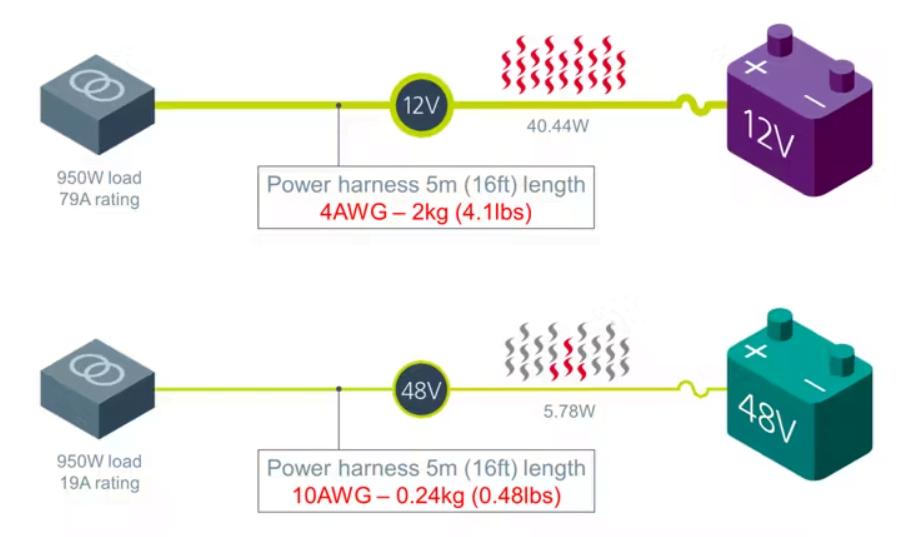
In addition to the weight and cost savings, switching to a 48-Volt power system can dramatically reduce resistive losses that could directly impact an EV’s range. Using the previous example, we find that switching to the higher voltage (and lower current) drops the harnesses’ resistive losses from 40 W to only 5.8 W. When multiplied by the number of high-power subsystems used in a typical EV, the potential savings can shave the vehicle’s weight by 100-150 lbs. and eliminate enough resistive losses to contribute roughly 10 km to its range.
A Modest Advance to 48 Volt:
As of right now, Tesla appears to be the only manufacturer who has completely adopted 48-V power, starting with its impending Cyber Truck and continuing with design modifications that will remove the 12-V bus from a number of its current vehicles. In addition to the aforementioned benefits, it has been rumored that Tesla has already established a “secret” accessories team tasked with creating goods like air compressors, winches, and lighting that are especially made for the 48-V design.
Most other automakers, though, will have to distribute the enormous costs of overhauling their designs, manufacturing lines, and supply chains over a much longer period.
During the expected 10- to 15-year period transition to 48-V power, many vehicles will continue to use existing 12-V accessories and subsystems that work well and would be too costly to re-engineer immediately. This can be accomplished by running a legacy 12-V harness throughout the vehicle.
In a distributed system, the vehicle’s 48 V is derived from the vehicle’s primary 400/800-V battery and then sent to 12-V power converters located close to the load points. Redundant power for braking, steering, and other ASIL D safety-critical functions can be derived by feeding them with two or more independent, isolated voltage converters.
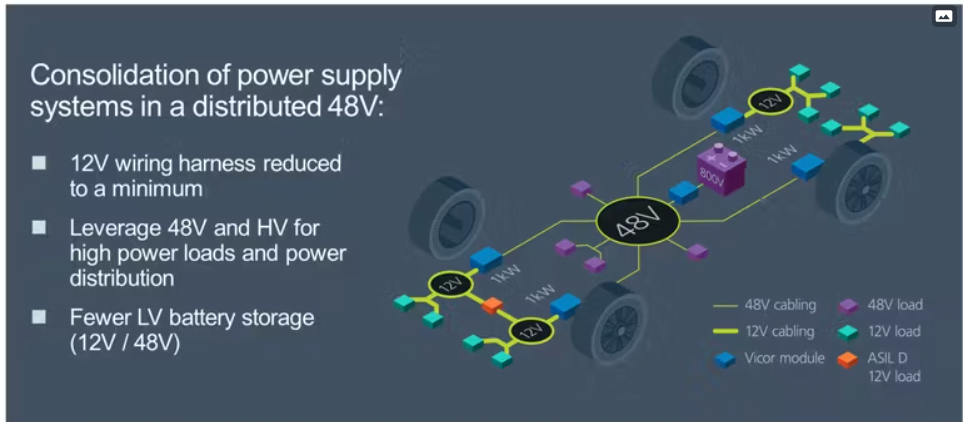
Transitioning to a 48-V power architecture also raises the question about where the 48 V will come from. In the case of Tesla, the company has chosen to power the 48-V bus via a small standalone lithium-ion auxiliary battery that’s charged from the vehicle’s main battery pack.
Alternatively, some manufacturers may choose to eliminate the need for a separate 48-V battery by creating a “virtual” battery consisting of a low-impedance converter, regulator, and small storage devices, such as supercapacitors. This would provide hold-up power for the door lock and other systems that must remain active while the main battery is disconnected.
Getting Started
The details of a particular manufacturer’s transition to 48 V will vary greatly depending on their products, their technical maturity, and the requirements of the customers they serve. But nearly anyone beginning the journey can benefit from a solid grounding in the basic standards and design practices related to the technologies they will be using. This includes:
- ISO 217804 covers requirements and tests for the electric and electronic components in road vehicles equipped with an electrical system operating at a nominal voltage of 48 V dc. This includes general requirements on 48-V dc electrical systems, voltage ranges, and slow voltage transients and fluctuations (not including EMC).
- The VDA Recommendation 3205 is published and maintained by the ZVEI-German Electrical and Electronic Manufacturers’ Association. It covers a wide range of specifications and test requirements for electric and electronic components in motor vehicles for the development of a 48-V power supply. ZVEI’s document “48-Volt Electrical Systems – A Key Technology Paving to the Road to Electric Mobility”6 provides practical insights about the requirements posed by VDA 320 and their fulfillment.
You can check out the video on 48 Volt Architecture:
